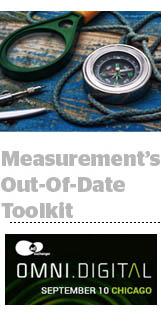 The executives in this story will appear at AdExchanger’s Omni.Digital conference on Sept. 10, an event designed to educate marketers on advanced solutions for building seamless cross-channel brand experiences.
The executives in this story will appear at AdExchanger’s Omni.Digital conference on Sept. 10, an event designed to educate marketers on advanced solutions for building seamless cross-channel brand experiences.
It’s still unclear how effective mobile advertising can be, despite its explosive growth.
For instance, mobile passed desktop in terms of user content consumption in early 2014, but still accounts for less than half of all digital ad spending.
One of the heaviest drags on mobile spending is the limitation of mobile measurement; vendors know progress in data collection opens budgets. For example, MediaLets CEO Richy Glassberg said that when the company began incorporating view-through metrics into its reporting – expanding mobile visibility from a single conversion into more of a funnel – ad spending on its servers increased as well.
“Most [marketers] invest because they understand that it’s strategic,” said Steve Latham, CEO at Encore Media Metrics, an attribution software provider. “But they struggle to show ROI for mobile, and it undercuts budget decisions.”
Limitations in mobile measurement force reliance on last-click conversions, Latham said. This is because mobile ad servers are typically restricted to a single data point on an ad click-through or conversion, whereas desktop ad servers provide access to the whole user conversion path. And, Glassberg pointed out, desktop’s 15-year head start over mobile gives it a broader amount of raw data to build upon.
But while mobile measurement accounts for the end of a sales funnel, numerous industry executives believe mobile represents an important mid-funnel marketing position (i.e., it affects user decisions but doesn’t have desktop’s direct sale utility).
Attribution firms acknowledge that as mobile experience matures the data will become more refined. But for tech companies anxious to connect marketing across channels, tracking only the final step in a long marketing funnel is like trying to fix a roof with a one-rung ladder.
Latham was surprised about the lack of urgency to solve this problem, at least outside the walls of big, closed platforms like Facebook, where marketers could do comprehensive attribution measurement if they only had access to the data.
Blaming the problem on the limitations of cookies in a mobile environment does a disservice to the industry, said Trevor Testuwide, CEO of the attribution firm Conversion Logic. Testuwide pointed that user-level tracking is possible to do, but is “labor intensive” and “heavy on integrations” for both the ad server and the analytics firm.
Testuwide and Latham both called for more vendors in the space to scale the laborious work of aggregating data from apps and collecting mobile log files.
Here’s the problem: There are numerous channel categories labeled “mobile” that should be separate. It’s now common for app developers to deep-link to the app store from the mobile web, but it’s counterproductive to conflate the strategies and metrics that are effective for mobile web ads vs. in-app ads.
Apps are “a total silo,” said Graham Ratcliffe, a co-founder and VP of product at Abakus, another attribution tech provider. Tracking individual users within the platform can be done fairly well, but it requires custom integrations across a massive ecosystem. App developers also must agree to enable measurement for marketers.
Ratcliffe said the industry is still a ways from “reaching the point where it can support fully accurate measurement,” but also that it’s important to focus on the progress, not the finish line. “Being right 60% of the time is still valuable.”
“Users aren’t necessarily purchasing on handheld devices,” Testuwide said. “But that mobile advertising is prompting a conversion on desktop later.”
The counterintuitive point Latham and Testuwide must impress on marketers is that, even if you’re laser-focused on direct sales, if you can’t fit mobile into a conversion funnel it means you will overlook its contributions.
The second-degree effects are significant as well. Ratcliffe said one performance tech vendor that licenses Abakus’s software blocks mobile activity because it won’t get credit due to the lack of tracking.











